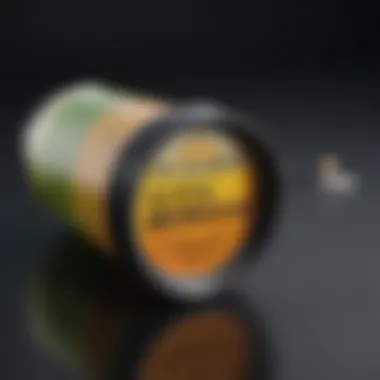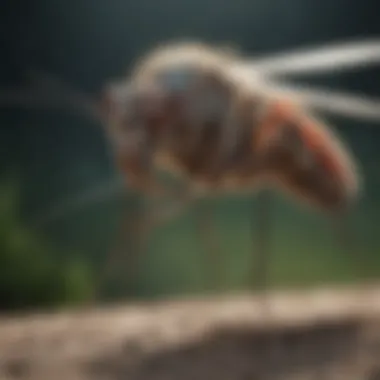Mosquito Ointment: Efficacy and Application Insights


Intro
In recent years, the prevalence of mosquito-borne diseases has heightened the need for effective personal protection strategies. Among these strategies, mosquito ointments have garnered attention. They offer a practical solution to deter mosquito bites and minimize the risk of diseases such as malaria and dengue. Understanding the formulation and efficacy of these ointments is essential. This article will explore various aspects, starting with a research overview to lay the groundwork for understanding the interplay of active ingredients and their effectiveness.
Research Overview
Summary of Key Findings
Research into mosquito ointments reveals several vital points. First, the active ingredients play a crucial role in determining the ointment's effectiveness. Chemicals like DEET, picaridin, and oil of lemon eucalyptus are commonly used. Studies indicate that DEET remains one of the most effective ingredients. Its high efficacy is attributed to its ability to mask human scents that attract mosquitoes.
"Active ingredients not only repel mosquitoes but also serve to provide a barrier that guards against bites."
Secondly, the formulation of the ointment impacts both its application and efficacy. Gel formulations tend to provide longer-lasting protection than spray types. Furthermore, the method of application significantly contributes to the overall effectiveness. Proper application ensures that the targeted areas are sufficiently covered to prevent mosquito landings.
Importance of the Research
The study of mosquito ointments is exceptionally relevant in today's context. The rise of mosquito-borne diseases emphasizes the need for effective deterrents. Researchers continue to investigate new formulations and compounds that may yield better protection while being environmentally friendly. Understanding the dynamics of mosquito behavior and adapting to these insights can lead to more innovative approaches in developing repellents.
Methodology
Study Design
The methodology typically employs a mixed-methods approach. Quantitative studies often involve controlled trials that measure the effectiveness of various formulations against specific mosquito species. Qualitative studies may include user feedback to assess usage patterns and preferences.
Data Collection Techniques
Data collection often involves experimentation in lab settings as well as field trials. Using standardized protocols helps ensure consistency, allowing researchers to draw accurate comparisons. Surveys and interviews also provide insight into user experiences and perceptions, enriching the understanding of product effectiveness.
Understanding the effectiveness of mosquito ointments involves detailed research and analysis. Each aspect of formulation, active ingredients, and application plays a role in the broader goal of personal protection against mosquitoes. A comprehensive view helps in navigating the current landscape and its future directions.
Preamble to Mosquito Ointment
Mosquito ointments serve as a critical line of defense for individuals exposed to environments where mosquito populations thrive. Understanding these products is essential not just for personal comfort, but also for preventing mosquito-borne diseases. The following sections explore the specific elements of efficacy, application, and considerations surrounding mosquito ointments, particularly as they relate to public health.
The Need for Protection
Mosquitoes are vectors for various diseases. In many regions, exposure can lead to serious illnesses such as malaria, dengue fever, and Zika virus. Protection against these mosquitoes is crucial in reducing the risk of infection. Ointments and repellents can significantly lower the likelihood of mosquito bites, providing a safer outdoor experience.
Additionally, mosquitoes are not just a nuisance. Their bites can cause allergic reactions, itching, and discomfort, impacting one's quality of life. This makes the use of effective mosquito ointments not merely advisable, but necessary for many individuals, especially in high-risk areas. The choice of an appropriate ointment becomes an informed decision that can protect health.
Historical Perspective
The use of mosquito repellent strategies has ancient roots. Historically, people have employed various methods to ward off mosquitoes, ranging from natural substances to more advanced chemicals. In ancient civilizations, ingredients like lemongrass and citronella have been used to deter mosquitoes. As societies evolved, so did the complexity and effectiveness of these remedies.
In the 20th century, synthetic compounds began to dominate the market. Ingredients like DEET were developed and incorporated into commercial products, providing longer-lasting protection. Insights into this evolution reveal trends in both consumer needs and the broader implications for public health. The changing landscape of mosquito control reflects not only advancements in formulation but also increasing awareness of the interplay between environmental factors and personal health practices.


"Understanding the historical context of mosquito protection aids in appreciating the current innovations in the field."
As research continues to explore new formulations and effective combinations of ingredients, the importance of mosquito ointments remains relevant in modern society. The ongoing battle against mosquito-borne diseases underscores the significance of effective personal protection. This article aims to provide a comprehensive examination of mosquito ointments, detailing their formulation, effectiveness, and implications for public health.
Understanding Mosquitoes
Understanding mosquitoes is vital in grasping the effectiveness of mosquito ointments. It helps in contextualizing the challenges that arise from mosquito-borne diseases. The lifecycle, habitat, and behavior of mosquitoes directly influence how and when these pests interact with humans. Knowledge in this area can enhance the efficacy of personal protection strategies, including the application of mosquito ointments.
Biology of Mosquitoes
Mosquitoes belong to the family Culicidae. Their biology reveals a complex structure that enables them to thrive in various environments. Adult mosquitoes have a slender body and long legs. The antennae are sensitive and play a crucial role in locating hosts. Female mosquitoes require blood for their eggs, making them the main culprits for bites.
The life cycle of mosquitoes consists of four stages: egg, larva, pupa, and adult. Each stage occurs in aquatic environments. Eggs, often laid in stagnant water, hatch into larvae, which feed on organic material. After undergoing several molts, larvae transition to pupae. Finally, they emerge as adults. Understanding this cycle helps inform the timing and strategy for applying mosquito ointments.
Habitat and Behavior
Mosquitoes thrive in diverse habitats, including wetlands, ponds, and even containers filled with water. Their behavior varies significantly across species. For example, Aedes mosquitoes tend to bite during the day, while Anopheles mosquitoes are more active at night.
Key behaviors include:
- Flight Patterns: Mosquitoes are attracted to carbon dioxide, heat, and sweat, making humans prime targets.
- Breeding Sites: Understanding where mosquitoes breed allows for targeted interventions.
By knowing mosquito habitats and behaviors, individuals can make more informed decisions about when and where to apply mosquito ointments. This information is vital for both personal safety and public health initiatives aimed at reducing mosquito populations and preventing disease transmission.
Formulation of Mosquito Ointment
The formulation of mosquito ointment is crucial to its overall efficacy and safety. Different formulations determine how well the product can protect against mosquito bites. This relationship between ingredients and effectiveness is essential for consumers and researchers alike. Understanding the types of ingredients used, their actions, and their potential side effects informs both usage choices and future development.
Common Ingredients
Natural Ingredients
Natural ingredients, such as citronella oil, lavender oil, and neem oil, are popular choices in mosquito ointments. Their appeal lies in their origin; many consumers prefer products derived from plant sources. These ingredients often possess mild properties, making them suitable for individuals with sensitive skin. However, the efficacy of natural repelents can vary significantly. Some may not provide as long-lasting protection as synthetic alternatives. Their effectiveness is often influenced by environmental variables like humidity and temperature, which can limit their practical use.
Synthetic Compounds
Synthetic compounds are widely used in mosquito ointments for their proven effectiveness. Ingredients like DEET and Picaridin are well-researched and noted for their ability to repel mosquitoes effectively. The key characteristic of synthetic ingredients is their ability to offer longer-lasting protection, sometimes exceeding several hours. However, concerns arise regarding their safety. Some users report skin irritation or allergic reactions. These issues highlight the need for careful consideration during product selection among users.
Carrier Oils
Carrier oils, such as coconut oil or jojoba oil, play a significant role in the formulation of mosquito ointments. They serve to dilute the active ingredients and enhance skin absorption. Carrier oils can also moisturize the skin, improving overall comfort during application. Their key characteristic is their ability to provide a barrier, which may enhance the longevity of mosquito repellents. However, the properties of carrier oils can influence how other ingredients perform. For instance, a heavier oil might reduce the effectiveness of lighter, more volatile compounds.
Mechanisms of Action
Repellency
Repellency is the primary action of mosquito ointments. Active ingredients engage in a biochemical interaction that confuses the mosquito’s sensory receptors. The effectiveness of this repellency is measured by its ability to prevent bites. Different active ingredients can vary in effectiveness depending on mosquito species. Consumer interest in repellency stems from the need for reliable protection, especially in areas with high incidences of mosquito-borne diseases.
Skin Absorption


Skin absorption is another significant aspect of mosquito ointments. It refers to how well the ointment penetrates the skin barrier. Ingredients that enhance skin absorption can deliver more active compounds into the skin. This may provide a more immediate effect. However, rapid absorption could lead to diminished effectiveness over time, thus altering how long a consumer can expect protection from a single application.
Duration of Effect
The duration of effect is crucial for consumers looking for prolonged protection. Some compounds last much longer on the skin than others. For example, DEET can provide several hours of protection, while natural ingredients may require more frequent applications. Understanding this aspect is essential for daily use, especially in regions with high mosquito populations. While longer-lasting products may tend to be more favorable, considerations about potential skin irritation or environmental impact also come into play.
Efficacy of Mosquito Ointment
The efficacy of mosquito ointment is significant in both personal health and public health contexts. Understanding how effective these ointments are against different species of mosquitoes can help individuals make informed choices about their use. The potential benefits include not only protection from mosquito bites but also a reduction in the transmission of mosquito-borne illnesses. However, various factors can influence the overall effectiveness.
Comparative Effectiveness
Against Aedes Species
Aedes mosquitoes, particularly Aedes aegypti, are known vectors for dengue fever, Zika virus, and chikungunya. Their bite is often associated with allergic reactions. The effectiveness of mosquito ointments against Aedes is generally measured by their ability to prevent bites and reduce the risk of disease transmission. Mosquito ointments that contain DEET or Picaridin are particularly well-regarded. They provide a long-lasting barrier against these mosquitoes, which makes them a popular choice in regions where these species are prevalent. The main benefit of using ointments targeting Aedes is their ability to effectively reduce the risk of transmission of serious diseases.
Against Anopheles Species
Anopheles mosquitoes are primarily known for transmitting malaria, which remains a major public health concern in many parts of the world. The efficacy of mosquito ointments against Anopheles species varies, but those containing permethrin or oil of lemon eucalyptus have shown effectiveness. These ingredients work by either repelling mosquitoes or interfering with their ability to land and bite. This effectiveness is essential as malaria can lead to severe health complications. However, the use of ointments should be part of a broader strategy that includes other preventive measures, such as bed nets and insecticides, to combat malaria transmission.
Clinical Studies
Clinical studies on the efficacy of mosquito ointments provide a scientific basis for their use. Research findings suggest that formulations with higher concentrations of active ingredients often yield better results. For instance, a study showing that a 30% DEET ointment offers prolonged protection compared to lower concentrations. These studies emphasize not only the effectiveness but also the importance of proper application for maximum benefit. However, it's crucial to consider that results may vary across different environments and populations, highlighting the need for further research to establish consistent guidelines for use.
Limitations and Considerations
Environmental Factors
Environmental factors can greatly impact the effectiveness of mosquito ointments. High humidity and temperature levels can affect how long the active ingredients remain effective on the skin. Additionally, areas with high mosquito populations may see increased chances of biting, even with the use of repellents. Understanding these factors can aid in choosing the right product for a specific context.
Application Techniques
The method of application can also influence efficacy. Rubbing ointments into the skin thoroughly can improve their effectiveness, while insufficient application may lead to increased bites. Furthermore, the timing of application before exposure to mosquitoes influences how well the ointment works. Applying it before entering a mosquito-prone area is advisable.
Individual Variability
Individual variability also plays a role in the efficacy of mosquito ointments. Skin type, body chemistry, and even diet can influence how well a repellent works for a person. Some people may experience better protection with certain formulations, while others may find those same products ineffective. Thus, it is advised to test different options to find the most effective personal protection for individual needs.
Understanding the efficacy of mosquito ointments is not just vital for personal safety; it is integral to public health efforts against mosquito-borne diseases.
Public Health Perspective
Understanding the public health perspective on mosquito-borne diseases and the role of repellents is essential. This context provides a framework for evaluating the effectiveness and necessity of mosquito ointments. Indeed, these products serve a dual purpose. They offer personal protection while contributing to broader public health efforts aimed at controlling the spread of diseases.
Mosquito-borne Diseases
Dengue Fever
Dengue fever remains a significant health concern globally. It is caused by the dengue virus, transmitted primarily by the Aedes mosquito. The disease can lead to severe flu-like symptoms, and in some cases, progress to a life-threatening condition known as severe dengue. The impact of dengue on public health is substantial, as it affects millions each year, particularly in tropical and subtropical regions. Highlighting its rapid spread underscores the need for effective mosquito repellents. A key characteristic of dengue is its ability to cause epidemics. Effective prevention through repellents is thus critical to protect individuals and curb outbreaks. However, one disadvantage of focusing solely on repellents is the need for a comprehensive approach that includes vaccination and community awareness.


Malaria
Malaria is another prevalent mosquito-borne disease, caused by parasites transmitted through Anopheles mosquitoes. It poses a serious threat, particularly in sub-Saharan Africa and parts of Asia. The significance of malaria in public health discourse cannot be understated, given it results in high morbidity and mortality. A key feature of malaria is its vector’s complex lifecycle, requiring multi-faceted strategies for prevention. Mosquito ointment can play a crucial role in individual protection. However, its efficacy can be limited when people do not apply it correctly or consistently. Therefore, alongside personal use, education about proper application techniques is essential for maximizing protection against malaria.
Zika Virus
The Zika virus, transmitted chiefly by Aedes species mosquitoes, gained international attention due to its association with neurological disorders, particularly microcephaly in newborns. The rapid spread of Zika highlighted the necessity of effective mosquito control and prevention measures. Zika is particularly noteworthy due to its potential for serious birth defects. Thus, mosquito ointment becomes a vital tool in protecting vulnerable populations, specifically pregnant individuals. Nevertheless, the awareness about Zika and the behaviors surrounding repellent use often vary, leading to questions about overall prevention efficacy.
Role of Repellents in Prevention
Repellents serve as a critical line of defense against mosquito bites and, consequently, mosquito-borne diseases. They not only protect individuals but also help reduce the transmission cycle of these diseases within communities. Effective use of repellents can decrease the incidence of diseases, contributing to better public health outcomes. Moreover, it is essential to consider how environmental factors, personal behaviors, and innovation in repellent formulations can enhance the efficacy of these products. As science advances, new compounds emerged, emphasizing the need for ongoing research and development in this field to ensure that mosquito ointments remain a reliable option for public health.
Research and Development
Research and development play a crucial role in the advancement of mosquito ointments. Understanding the efficacy and formulation of these products can significantly impact public health strategies against mosquito-borne diseases. Through dedicated research, scientists can identify effective active ingredients, assess their safety and usability, and develop innovative delivery mechanisms that enhance the users' experience. The ongoing development of these formulations also facilitates solutions that resonate with consumers' preferences and environmental considerations, underscoring the need for continual assessment and adaptation in this field.
Innovative Approaches
Novel Compounds
Novel compounds represent a frontier in mosquito repellent technology. These substances are designed to offer enhanced protection against mosquitoes while minimizing side effects. A key characteristic of novel compounds is their targeted action; they can be engineered to disrupt mosquito behavior more effectively than traditional ingredients, such as DEET or picaridin. An important attribute of these compounds is their ability to remain effective over an extended duration, which is ideal for users seeking long-lasting protection.
However, the introduction of novel compounds also brings its challenges. Regulatory hurdles can delay their market entry, and long-term studies are often needed to evaluate safety and effectiveness comprehensively. Nonetheless, the potential benefits of these compounds position them as a promising solution in developing effective mosquito ointments.
Bioengineering Mosquitoes
Bioengineering mosquitoes represents a radical approach to controlling mosquito populations and thus reducing the transmission of diseases. This strategy involves modifying mosquito genetics to render them incapable of transmitting pathogens. A significant feature of this method is its sustainability; by reducing mosquito populations biologically, reliance on chemical repellents can diminish over time.
The advantage of bioengineering lies in its long-term impact. By altering the mosquito population, the need for continual application of ointments may be lessened, making it an environmentally friendly alternative. However, ethical concerns and ecological impact assessments must be addressed. The complexity of ecosystem interactions means that such interventions need thorough scrutiny before practical implementation.
Community-Based Interventions
Community-based interventions focus on enhancing public awareness and equipping residents with tools to combat mosquito problems. Effective strategies may include educational programs about the importance of proper environmental management, such as eliminating standing water, which serves as mosquito breeding sites. A notable advantage of this approach is the communal involvement it fosters, empowering locals to take charge of their health.
These interventions can lead to an overall reduction in mosquito populations. However, they require sustained engagement and resources, which can sometimes pose challenges in underserved areas. By prioritizing community participation, the long-term reduction of mosquito-borne diseases becomes feasible, making it a valuable strategy in public health.
Future Directions
Long-Term Studies
Long-term studies are essential for understanding the effectiveness and safety of mosquito ointments. These studies can provide insights into how various formulations perform over extended periods, which is critical for both consumers and manufacturers. A crucial aspect of these studies is the ability to gather comprehensive data on efficacy and user satisfaction in real-world settings, beyond short-term clinical trials.
While beneficial, conducting long-term studies can be resource-intensive and require extensive planning. However, the data obtained can foster trust in products and enhance regulatory approvals, making these studies valuable for the development of future mosquito ointments.
Regulatory Considerations
Regulatory considerations are a significant aspect of developing new mosquito repellents. Adhering to safety standards imposed by organizations such as the Environmental Protection Agency (EPA) or the Food and Drug Administration (FDA) is paramount. These regulations often necessitate rigorous testing for both safety and effectiveness before a product can reach the market.
Understanding these regulations helps researchers and organizations navigate the complex landscape of product approval. Compliance not only ensures consumer safety but also strengthens the credibility of the mosquito ointment industry. On the downside, stringent regulations may slow down innovation and delay the release of new products.
Global Collaboration
Global collaboration among researchers, governments, and organizations is vital in tackling the challenges posed by mosquito-borne diseases. Collaborative efforts can lead to shared resources, knowledge, and technologies that benefit all parties involved. A key characteristic of global collaboration is its potential for innovative solutions that far exceed what individual entities could achieve.
Such partnerships can also mobilize resources towards areas most affected by diseases, pooling expertise to create more effective interventions. However, coordinating across different countries can present challenges, including differing regulations and priorities among stakeholders. Nonetheless, the advantages of global collaboration in creating unified and sustainable strategies for mosquito control are substantial.



